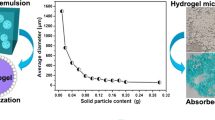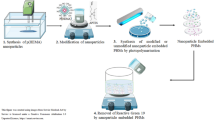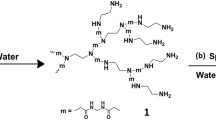Abstract
Hydrogel microparticles (HMPs) were synthesized via reverse emulsion/UV light polymerization and employed as adsorbents for removing bisphenol A (BPA) from aqueous solution. Results demonstrated the smooth surface of HMPs, with particle size ranging from 137 to 535 μm. Functional groups, including –OH, C–O, C=O, and C–H, are all involved in BPA adsorption confirmed by FTIR. Effect of solution pH, contact time, and initial BPA concentration on adsorption process was examined. The adsorption capacity was found pH independent below pH 8.0 and decreased when pH values greater than 8.0. The maximum adsorption capacity of the HMPs for BPA was 174.77 mg/g. The adsorption process achieved an equilibrium state within 30 min by the pseudo-second-order kinetic rather than the other kinetic models and was fitted well with the Freundlich linear isotherm model. Also, the obtained isotherms reflected the formation of S-type isotherm curve according to Giles’s classification. The BPA loaded on the HMPs could be totally regenerated by methanol/dimethylsulfoxide and can be used for five cycles maintaining 100% of adsorption capacity. When the HMPs were applied for the treatment of spiked real surface water, excellent results were also achieved indicating the high efficiency and potential of the adsorbent.








Similar content being viewed by others
References
Abukhadra MR, Dardir FM, Shaban M, Ahmed EA, Soliman MF (2018) Superior removal of Co2+ , Cu2+ and Zn2+ contaminants from water utilizing spongy Ni/Fe carbonate-fluorapatite; preparation, application and mechanism. Ecotoxicol Environ Saf 157:358–368
Bele S, Samanidou V, Deliyanni E (2016) Effect of the reduction degree of graphene oxide on the adsorption of bisphenol A. Chem Eng Res Des 109:573–585
Ben Ouada S, Ben Ali R, Leboulanger C, Ben Ouada H, Sayadi S (2018) Effect of bisphenol A on the extremophilic microalgal strain Picocystis sp. (Chlorophyta) and its high BPA removal ability. Ecotoxicol Environ Saf 158:1–8
Bhatnagar A, Anastopoulos I (2017) Adsorptive removal of bisphenol A (BPA) from aqueous solution: a review. Chemosphere 168:885–902
Bhattacharyya R, Ray SK (2015) Adsorption of industrial dyes by semi-IPN hydrogels of acrylic copolymers and sodium alginate. J Ind Eng Chem 22:92–102
Cajthaml T, Křesinová Z, Svobodová K, Möder M (2009) Biodegradation of endocrine-disrupting compounds and suppression of estrogenic activity by ligninolytic fungi. Chemosphere 75:745–750
Chang Z, Tian L, Wu M, Dong X, Peng J, Pan B (2018) Molecular markers of benzene polycarboxylic acids in describing biochar physiochemical properties and sorption characteristics. Environ Pollut 237:541–548
Cheng J, Zhang P, Liu T, Zhang J (2015) Preparation and properties of hydrogels based on PEG and isosorbide building blocks with phosphate linkages. Polymer 78:212–218
Chhaya U, Gupte A (2013) Possible role of laccase from Fusarium incarnatum UC-14 in bioremediation of bisphenol A using reverse micelles system. J Hazard Mater 254-255:149–156
Dehghani MH, Mahvi AH, Rastkari N, Saeedi R, Nazmara S, Iravani E (2014) Adsorption of bisphenol A (BPA) from aqueous solutions by carbon nanotubes: kinetic and equilibrium studies. Desalin Water Treat 54:84–92
Dehghani MH, Ghadermazi M, Bhatnagar A, Sadighara P, Jahed-Khaniki G, Heibati B, McKay G (2016) Adsorptive removal of endocrine disrupting bisphenol A from aqueous solution using chitosan. J Environ Chem Eng 4:2647–2655
Dil NN, Sadeghi M (2018) Free radical synthesis of nanosilver/gelatin-poly (acrylic acid) nanocomposite hydrogels employed for antibacterial activity and removal of Cu(II) metal ions. J Hazard Mater 351:38–53
Duan F, Chen C, Zhao X, Yang Y, Liu X, Qin Y (2016) Water-compatible surface molecularly imprinted polymers with synergy of bi-functional monomers for enhanced selective adsorption of bisphenol A from aqueous solution. Environ Sci: Nano 3:213–222
Fosso-Kankeu E, Mittal H, Mishra SB, Mishra AK (2015) Gum ghatti and acrylic acid based biodegradable hydrogels for the effective adsorption of cationic dyes. J Ind Eng Chem 22:171–178
Garcia-Morales R, Rodríguez-Delgado M, Gomez-Mariscal K, Orona-Navar C, Hernandez-Luna C, Torres E, Parra R, Cárdenas-Chávez D, Mahlknecht J, Ornelas-Soto N (2015) Biotransformation of endocrine-disrupting compounds in groundwater: bisphenol A, nonylphenol, ethynylestradiol and triclosan by a laccase cocktail from Pycnoporus sanguineus CS43. Water Air Soil Pollut 226:251–264
Gassara F, Brar SK, Verma M, Tyagi RD (2013) Bisphenol A degradation in water by ligninolytic enzymes. Chemosphere 92:1356–1360
Giles CH, MacEwan TH, Nakhwa SN, Smith D (1960) Studies in adsorption. Part XI. A system of classification of solution adsorption isotherms, and its use in diagnosis of adsorption mechanisms and in measurement of specific surface areas of solids. J Chem Soc 0:3973–3993. https://doi.org/10.1039/jr9600003973
Han C, Hong Y (2016) Bisphenol A, hypertension, and cardiovascular diseases: epidemiological, laboratory, and clinical trial evidence. Curr Hypertens Rep 18:11–15
Hou Z, Wen Z, Wang D, Wang J, Philippe François-Xavier C, Wintgens T (2018) Bipolar jet electrospinning bi-functional nanofibrous membrane for simultaneous and sequential filtration of Cd2+ and BPA from water: competition and synergistic effect. Chem Eng J 332:118–130
Huang YQ, Wong CKC, Zheng JS, Bouwman H, Barra R, Wahlström B, Neretin L, Wong MH (2012) Bisphenol A (BPA) in China: a review of sources, environmental levels, and potential human health impacts. Environ Int 42:91–99
Jiang W, Yan Y, Ma M, Wang D, Luo Q, Wang Z, Satyanarayanan SK (2012) Assessment of source water contamination by estrogenic disrupting compounds in China. J Environ Sci 24:320–328
Kampmann M, Boll S, Kossuch J, Bielecki J, Uhl S, Kleiner B, Wichmann R (2014) Efficient immobilization of mushroom tyrosinase utilizing whole cells from Agaricus bisporus and its application for degradation of bisphenol A. Water Res 57:295–303
Kampmann M, Hoffrichter A-C, Stalinski D, Wichmann R (2015) Kinetic characterization of tyrosinase containing mushroom (Agaricus bisporus) cells immobilized in silica alginate. J Mol Catal B Enzym 116:124–133
Karnam SS, Ghosh RC, Mondal S, Mondal M (2015) Evaluation of subacute bisphenol-A toxicity on male reproductive system. Vet World 8:738–744
Koduru JR, Lingamdinne LP, Singh J, Choo K-H (2016) Effective removal of bisphenol A (BPA) from water using a goethite/activated carbon composite. Process Saf Environ Prot 103:87–96
Kono H, Onishi K, Nakamura T (2013) Characterization and bisphenol A adsorption capacity of β-cyclodextrin–carboxymethylcellulose-based hydrogels. Carbohydr Polym 98:784–792
Kuo CY (2009) Comparison with as-grown and microwave modified carbon nanotubes to removal aqueous bisphenol A. Desalination 249:976–982
Kuroda N, Kinoshita Y, Sun Y, Wada M, Kishikawa N, Nakashima K, Makino T, Nakazawa H (2003) Measurement of bisphenol A levels in human blood serum and ascitic fluid by HPLC using a fluorescent labeling reagent. J Pharm Biomed Anal 30:1743–1749
Laatikainen K, Bryjak M, Laatikainen M, Sirén H (2013) Molecularly imprinted polystyrene-divinylbenzene adsorbents for removal of bisphenol A. Desalin Water Treat 52:1885–1894
Li C, Li XZ, Graham N, Gao NY (2008) The aqueous degradation of bisphenol A and steroid estrogens by ferrate. Water Res 42:109–120
Li Z, Gondal MA, Yamani ZH (2014) Preparation of magnetic separable CoFe2O4/PAC composite and the adsorption of bisphenol A from aqueous solution. J Saudi Chem Soc 18:208–213
Li S, Zhang G, Wang P, Zheng H, Zheng Y (2016) Microwave-enhanced Mn-Fenton process for the removal of BPA in water. Chem Eng J 294:371–379
Li X, Zhou M, Jia J, Ma J, Jia Q (2018) Design of a hyper-crosslinked β-cyclodextrin porous polymer for highly efficient removal toward bisphenol A from water. Sep Purif Technol 195:130–137
Libbrecht W, Vandaele K, De Buysser K, Verberckmoes A, Thybaut J, Poelman H, De Clercq J, Van Der Voort P (2015) Tuning the pore geometry of ordered mesoporous carbons for enhanced adsorption of bisphenol-A. Materials 8:1652–1665
Liu X, Hu Y, Huang J, Wei C (2016) Detailed characteristics of adsorption of bisphenol A by highly hydrophobic MCM-41 mesoporous molecular sieves. Res Chem Intermed 42:7169–7183
Manfo FPT, Jubendradass R, Nantia EA, Moundipa PF, Mathur PP (2014) Adverse effects of bisphenol A on male reproductive function. Rev Environ Contam Toxicol 228:57–82
Milosavljević NB, Ristić MĐ, Perić-Grujić AA, Filipović JM, Štrbac SB, Rakočević ZL, Kalagasidis Krušić MT (2011) Sorption of zinc by novel pH-sensitive hydrogels based on chitosan, itaconic acid and methacrylic acid. J Hazard Mater 192:846–854
Mohamed F, Abukhadra MR, Shaban M (2018) Removal of safranin dye from water using polypyrrole nanofiber/Zn-Fe layered double hydroxide nanocomposite (Ppy NF/Zn-Fe LDH) of enhanced adsorption and photocatalytic properties. Sci Total Environ 640-641:352–363
Orozco-Guareño E, Santiago-Gutiérrez F, Morán-Quiroz JL, Hernandez-Olmos SL, Soto V, Cruz WDL, Manríquez R, Gomez-Salazar S (2010) Removal of Cu(II) ions from aqueous streams using poly (acrylic acid-co-acrylamide) hydrogels. J Colloid Interface Sci 349:583–593
Paulino AT, Belfiore LA, Kubota LT, Muniz EC, Tambourgi EB (2011) Efficiency of hydrogels based on natural polysaccharides in the removal of Cd2+ ions from aqueous solutions. Chem Eng J 168:68–76
Qiu F, Peng M, Wei Z, Wang X, Yang J (2016) Preparation of polyethersulfone/sulfonated polyethersulfonephenylethane microspheres and its application for the adsorption of bisphenol A. J Appl Polym Sci 133. https://doi.org/10.1002/app.43066
Ragavan KV, Rastogia NK (2017) β-Cyclodextrin capped graphene-magnetite nanocomposite for selective adsorption of bisphenol-A. Carbohydr Polym 168:129–137
Rathnayake SI, Xi Y, Frost RL, Ayoko GA (2016) Environmental applications of inorganic–organic clays for recalcitrant organic pollutants removal: bisphenol A. J Colloid Interface Sci 470:183–195
Shaban M, AbuKhadra MR, Nasief FM, Abd El-Salam HM (2017a) Removal of ammonia from aqueous solutions, ground water, and wastewater using mechanically activated clinoptilolite and synthetic zeolite-A: kinetic and equilibrium studies. Water Air Soil Pollut 228:450–465
Shaban M, Hassouna MEM, Nasief FM, AbuKhadra MR (2017b) Adsorption properties of kaolinite-based nanocomposites for Fe and Mn pollutants from aqueous solutions and raw ground water: kinetics and equilibrium studies. Environ Sci Pollut Res 24:22954–22966
Shaban M, Abukhadra MR, Khan AAP, Jibali BM (2018) Removal of Congo red, methylene blue and Cr(VI) ions from water using natural serpentine. J Taiwan Inst Chem Eng 82:102–116
Shafeeyan MS, Daud WMAW, Houshmand A, Shamiri A (2010) A review on surface modification of activated carbon for carbon dioxide adsorption. J Anal Appl Pyrolysis 89:143–151
Sharma R, Kaith BS, Kalia S, Pathania D, Kumar A, Sharma N, Street RM, Schauer C (2015) Biodegradable and conducting hydrogels based on Guar gum polysaccharide for antibacterial and dye removal applications. J Environ Manag 162:37–45
Shi W, Hu G, Chen S, Wei S, Cai X, Chen B, Feng J, Hu X, Wang X, Yu H (2013) Occurrence of estrogenic activities in second-grade surface water and ground water in the Yangtze River Delta, China. Environ Pollut 181:31–37
Teppala S, Madhavan S, Shankar A (2012) Bisphenol A and metabolic syndrome: results from NHANES. Int J Endocrinol 2012:1–5
Wang N, Zhou Y, Fu C, Wang H, Huang P, Wang B, Su M, Jiang F, Fang H, Zhao Q, Chen Y, Jiang Q (2015) Influence of bisphenol A on thyroid volume and structure independent of iodine in school children. PLoS One 10:e0141248. https://doi.org/10.1371/journal.pone.0141248
Wang Q, Yang C, Zhang G, Hu L, Wang P (2017) Photocatalytic Fe-doped TiO2 /PSF composite UF membranes: characterization and performance on BPA removal under visible-light irradiation. Chem Eng J 319:39–47
Wolska J, Bryjak M (2014) Removal of bisphenol A from aqueous solution by molecularly imprinted polymers. Sep Sci Technol 49:1643–1653
Xia B, Krutkramelis K, Oakey J (2016) An oxygen-purged microfluidic device to enhance cell viability in photopolymerized PEG hydrogel microparticles. Biomacromolecules 17:2459–2465. https://doi.org/10.1021/acs.biomac.6b00597
Xu J, Tang T, Zhang K, Ai S, Du H (2011) Electroenzymatic catalyzed oxidation of bisphenol-A using HRP immobilized on magnetic silk fibroin nanoparticles. Process Biochem 46:1160–1165
Ying G-G, Toze S, Hanna J, Yu X-Y, Dillon PJ, Kookana RS (2008) Decay of endocrine-disrupting chemicals in aerobic and anoxic groundwater. Water Res 42:1133–1141
Zhang Z, Alomirah H, Cho H-S, Li Y-F, Liao C, Minh TB, Mohd MA, Nakata H, Ren N, Kannan K (2011) Urinary bisphenol A concentrations and their implications for human exposure in several Asian countries. Environ Sci Technol 45:7044–7050
Zhang Y, Zhang D, Zhou L, Zhao Y, Chen J, Chen Z, Wang F (2018) Polypyrrole/reduced graphene oxide aerogel particle electrodes for high-efficiency electro-catalytic synergistic removal of Cr(VI) and bisphenol A. Chem Eng J 336:690–700
Zhou Q, Wang Y, Xiao J, Fan H (2016) Adsorption and removal of bisphenol A, α-naphthol and β-naphthol from aqueous solution by Fe3O4@polyaniline core–shell nanomaterials. Synth Met 212:113–122
Zhu H, Li Z, Yang J (2018) A novel composite hydrogel for adsorption and photocatalytic degradation of bisphenol A by visible light irradiation. Chem Eng J 334:1679–1690
Zielińska M, Cydzik-Kwiatkowska A, Bernat K, Bułkowska K, Wojnowska-Baryła I (2014) Removal of bisphenol A (BPA) in a nitrifying system with immobilized biomass. Bioresour Technol 171:305–313
Funding
This work was supported by the Science and Technology Department of Siping City (2016053) and the Department of Science & Technology of Jilin Province of China (20180623042TC).
Author information
Authors and Affiliations
Corresponding author
Additional information
Responsible editor: Tito Roberto Cadaval Jr
Rights and permissions
About this article
Cite this article
Du, H., Piao, M. Facile preparation of microscale hydrogel particles for high efficiency adsorption of bisphenol A from aqueous solution. Environ Sci Pollut Res 25, 28562–28571 (2018). https://doi.org/10.1007/s11356-018-2879-0
Received:
Accepted:
Published:
Issue Date:
DOI: https://doi.org/10.1007/s11356-018-2879-0




